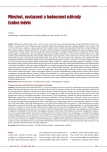Peritoneal dialysis and its modification in the treatment of chronic renal failure
Authors:
V. Bednářová; Z. Hrušková; V. Motáň; M. Neprašová
Authors‘ workplace:
Klinika nefrologie 1. lékařské fakulty UK a VFN Praha, přednosta prof. MUDr. Vladimír Tesař, DrSc.
Published in:
Vnitř Lék 2011; 57(7&8): 635-639
Category:
136th internal medicine day, XXIV. Vanýskův den, Brno 2011
Overview
Three methods can be used to treat chronic renal failure – haemodialysis, peritoneal dialysis and renal transplantation (from a living donor or transplantation of a cadaver kidney). In 2009, 5 763 patients were treated with haemodialysis in the Czech Republic, while peritoneal dialysis was used in just 8% (458) of patients. This low number of peritoneal dialyses may be due to the still high number of chronic renal failure patients who come to dialysis centres “off the street”. Following acute initiation of haemodialysis, these patients are usually retained on haemodialysis. Poor awareness of peritoneal dialysis among patients as well as health care professionals is another reason for the low number of peritoneal dialysis patients. Peritoneal dialysis is suitable for home treatment. Peritoneum serves as the dialysis membrane, peritoneal cavity is filled with dialysis solution and the metabolism waste products and water are excreted into this solution. A base to correct metabolic acidosis then passes from dialysis solution into the body. Permanent catheter is inserted into the abdominal cavity to enable infusion of the dialysis solution. The dialysis is continual and this ensures stability of the inner environment and thus most closely resembles own kidney function. The advantages of peritoneal dialysis include longer preservation of residual renal function, inner environment stability and no need for venous access. Peritoneal dialysis is associated with a lower risk of infections. Peritoneal dialysis is contraindicated in patients after an extensive intraabdominal surgery and in patients with a stoma. Peritoneal damage is a serious complication of peritoneal dialysis; the risk increases with the treatment duration and thus peritoneal dialysis is not a long-term treatment choice. With the traditional CAPD (continual ambulatory peritoneal dialysis), the patient performs an exchange of dialysis solution him/herself 4 to 5 times a day. With APD (automated peritoneal dialysis) a machine performs dialysis solution exchanges, dialysis is performed at night and the patient may engage in other activities during a day. From the perspective of log-term survival of patients with chronic renal failure, peritoneal dialysis appears to be the method of choice. The patient is first treated with peritoneal dialysis and subsequently receives a transplant. Should the renal allograft be rejected, the patient returns to the dialysis programme, either peritoneal or haemodialysis. Patients should be provided with true and objective information about their disease and be informed about all treatment options for chronic renal failure. The choice of method has to be tailored to the overall health status of the patient as well as his/her lifestyle.
Key words:
peritoneal dialysis – haemodialysis – transplantation – CAPD – automated peritoneal dialysis – peritonitis – peritoneal dialysis solution
Sources
1. Rychlík I, Lopot F. Statistická ročenka dialyzační léčby v České republice v roce 2009. Česká nefrologická společnost, 2010, www.nefrol.cz.
2. Bouvier N, Durand PY, Testa A et al. Regional discrepancies in peritoneal dialysis utilization in France: the role of the nephrologist’s opinion about peritoneal dialysis. Nephrol Dial Transplant 2009; 24: 1293–1297.
3. Perl J, Bargman JM. Predialysis interventions for postdialysis outcomes. Perit Dial Int 2009; 29: 270–273.
4. Guest S, Filho DJ, Krediet RT. Celebration of the 50th Anniversary of the thesis on peritoneal dialysis by Dr. Fred S.T. Boen. Perit Dial Int 2009; 29: 601–604.
5. Mendelssohn DC, Mujais SK, Soroka SD et al. A prospective evaluation of renal replacement therapy modilaty eligibility. Nephrol Dial Transplant 2009; 24: 555–561.
6. Vonesh EF, Snyder JJ, Foley RN et al. Mortality studies comparing peritoneal dialysis and hemodialysis: What do they tell us? Kidney Int Suppl 2006; 103: S3–S11.
7. Chiu YW, Jiwakanon S, Lukowsky L et al. An update on the comparison of mortality outcomes of hemodialysis and peritoneal dialysis patiens. Semin Nephrol 2011; 31: 152–158.
8. Fruktoso M, Castro R, Oliveira L et al. Quality of life in chronic kidney disease. Nephrologia 2011; 31: 91–96.
9. Kim YL. Update on mechanisms of ultrafiltration failure. Perit Dial Int 2009; 29 (Suppl 2): S123–S127.
10. Diaz-Buxo JA, Himmele R. Strategies to universally improve peritonitis rates, including use of dialysis solutions with low glucose degradation products. Adv Perit Dial 2010; 26: 37–40.
11. Tao Li PK, Szeto CC, Piraino B et al. Peritoneal dialysis – related infections recommendations: 2010 update. Perit Dial Int 2010; 30: 693–423.
12. Davies SJ, Mushahar L, Yu Z et al. Determinant of peritoneal membrane function over time. Semin Nephrol 2011; 31: 172–188.
13. Vonesh E. On small solute clearance and patient outcomes: evindental practice or observational trepidation? Perit Dial Int 2009; 29: 623–629.
14. NECOSAD Nephrol Dial Transplant 2007; 22: 2991–2998.
15. Bednářová V. Automatizovaná peritoneální dialýza. In: Bednářová V, Dusilová Sulková S et al (eds). Peritoneální dialýza. Praha: Maxdorf 2007: 216–231.
16. Sezer S, Karakan S, Özdemir AFN et al. Dialysis as a bridge to renal transplantation: comparison of graft outcomes according to mode of dialysis treatment. Transplant Proc 2011; 43: 485–487.
Labels
Diabetology Endocrinology Internal medicineArticle was published in
Internal Medicine

2011 Issue 7&8
Most read in this issue
- Haemodialysis – the current practice
- Anemia and chronic kidney failure
- Immunosuppressive therapy and its problems
- Aetiology and a clinical picture of chronic renal failure
